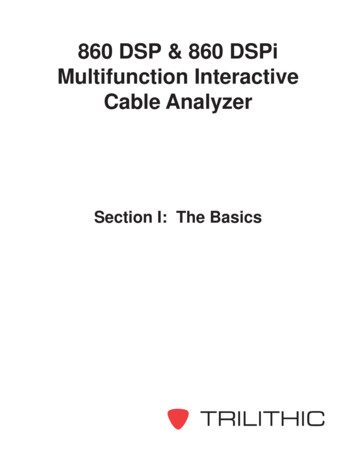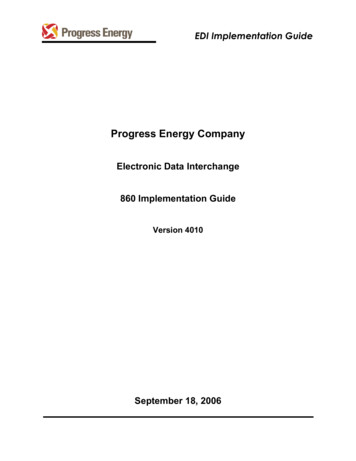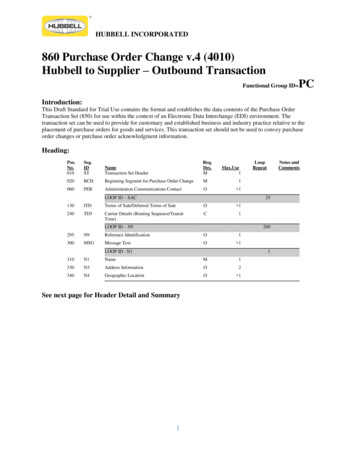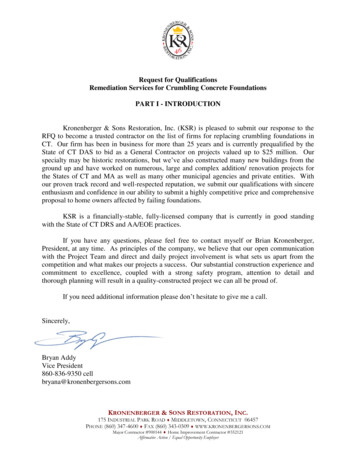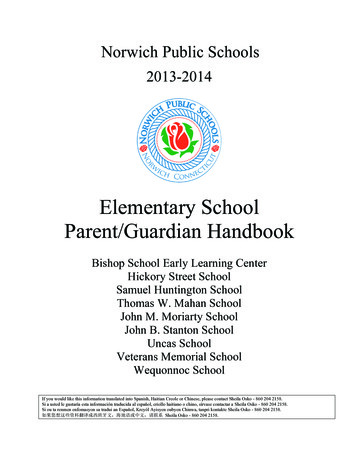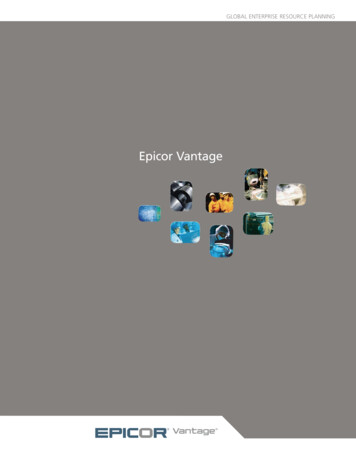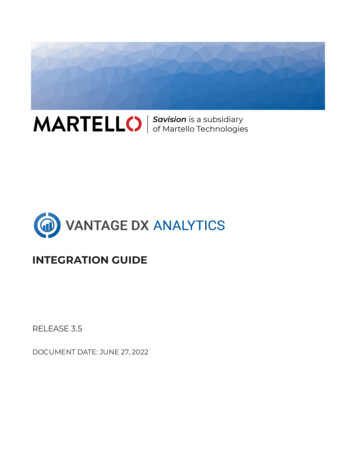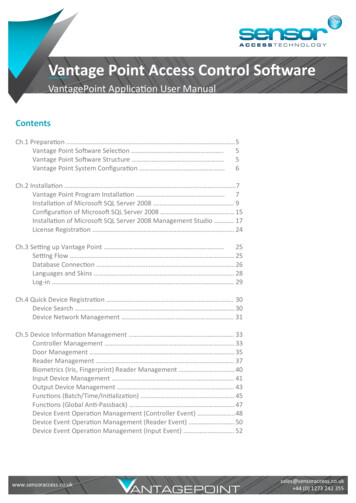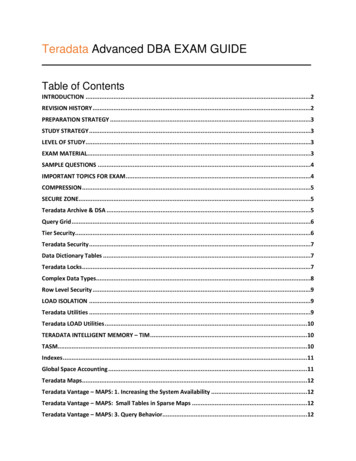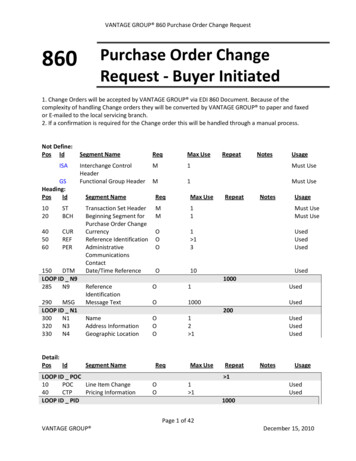
Transcription
VANTAGE GROUP 860 Purchase Order Change RequestPurchase Order ChangeRequest - Buyer Initiated8601. Change Orders will be accepted by VANTAGE GROUP via EDI 860 Document. Because of thecomplexity of handling Change orders they will be converted by VANTAGE GROUP to paper and faxedor E-mailed to the local servicing branch.2. If a confirmation is required for the Change order this will be handled through a manual process.Not Define:Pos LOOP ID N9285N9290MSGLOOP ID N1300N1320N3330N4Detail:PosIdSegment NameReqMax UseRepeatInterchange ControlHeaderFunctional Group HeaderM1Must UseM1Must UseRepeatNotesNotesUsageSegment NameReqMax UseUsageTransaction Set HeaderBeginning Segment forPurchase Order ChangeCurrencyReference ate/Time ReferenceMM11Must UseMust UseOOO1 ssage TextO1UsedO1000UsedNameAddress InformationGeographic LocationOOO12 1200Segment NameLOOP ID POC10POCLine Item Change40CTPPricing InformationLOOP ID PIDReqMax UseUsedUsedUsedRepeatNotesUsage 1OO1 1UsedUsed1000Page 1 of 42VANTAGE GROUP December 15, 2010
VANTAGE GROUP 860 Purchase Order Change Request50PID100REF180FOB200DTMLOOP ID eferenceIdentificationF.O.B. RelatedInstructionsDate/Time ReferenceO1UsedO 1UsedO 1UsedO10UsedReferenceIdentificationMessage TextO1UsedO1000Used1000Segment NameReqMax UseRepeatNotesUsageLOOP ID CTT10CTTTransaction Totals30SETransaction Set TrailerOM11UsedMust UseNot Define:GEIEAMM11Must UseMust UseFunctional Group HeaderInterchange ControlTrailer1Page 2 of 42VANTAGE GROUP December 15, 2010
VANTAGE GROUP 860 Purchase Order Change RequestISAPos:Max: 1Not Defined - MandatoryLoop: N/AElements: 16Interchange ControlHeaderUsedElement Summary:RefIdElement NameISA01I01Authorization ion InformationDescription:ISA03I03Security InformationQualifierDescription:ISA04I04Security InformationDescription:ISA05I05Interchange Sender IDQualifierDescription:ISA06I06Interchange Sender IDDescription:ISA07I07Interchange Receiver IDQualifierDescription:ISA08I08Interchange Receiver IDDescription:ISA09I09Interchange DateDescription:ISA10I10Interchange TimeDescription:ISA11I11Interchange ControlStandards IdentifierDescription:ISA12I12Interchange ControlVersion NumberDescription:ISA13I13Interchange uestedDescription:ISA15I15Usage IndicatorReqMTypeIDMin/Max2/2UsageMust useMAN10/10Must useMID2/2Must useMAN10/10Must useMID2/2Must useMAN15/15Must useMID2/2Must useMAN15/15Must useMDT6/6Must useMTM4/4Must useMID1/1Must useMID5/5Must useMN09/9Must useMID1/1Must useMID1/1Must usePage 3 of 42VANTAGE GROUP December 15, 2010
VANTAGE GROUP 860 Purchase Order Change RequestISA16I16Description:Component ElementSeparatoDescription:M1/1Must usePage 4 of 42VANTAGE GROUP December 15, 2010
VANTAGE GROUP 860 Purchase Order Change RequestGSPos:Max: 1Not Defined - MandatoryLoop: N/AElements: 8Functional GroupHeaderUsedElement Summary:RefIdElement NameGS01GS01Functional IdentifierCoderDescription:GS02GS02Application Sender’s CodeDescription:GS03GS03Application n:GS05GS05TimeDescription:GS06GS06Group Control NumberDescription:GS07GS07Responsible Agency CodeDescription:GS08GS08Version / Release /Industry Identifier CodeDescription:ReqMTypeIDMin/Max2/2UsageMust useMAN2/15Must useMAN2/15Must useMDT8/8Must useMTM4/8Must useMN01/9Must useMID1/2Must useMAN1/12Must usePage 5 of 42VANTAGE GROUP December 15, 2010
VANTAGE GROUP 860 Purchase Order Change RequestPos: 10Max: 1Header - MandatoryLoop: N/AElements: 2*See ASC X12 Nomenclature, to review the transaction set structure, including descriptions ofsegments, data elements, levels, and loopsUsedElement Summary:RefIdElement NameReqTypeMin/MaxUsageST001143Transaction Set saction Set ControlMAN4/9Must useNumberDescription:STTransaction Set HeaderPage 6 of 42VANTAGE GROUP December 15, 2010
VANTAGE GROUP 860 Purchase Order Change RequestBCHBeginning Segment forPurchase Order ChangeUsedElement Summary:RefIdElement NameBCH001 353Transaction Set PurposeCodeDescription:BCH002 92Purchase Order Type CodeDescription:BCH003 324Purchase Order NumberDescription:BCH006 373DateDescription:Pos: 20Max: 1Header - MandatoryLoop: N/AElements: 4ReqMTypeIDMin/Max2/2UsageMust useMID2/2Must useMAN1/22Must useM/ZDT8/8UsedPage 7 of 42VANTAGE GROUP December 15, 2010
VANTAGE GROUP 860 Purchase Order Change RequestCURPos: 40Max: 1Header - OptionalLoop: N/AElements: 2CurrencyUsedElement Summary:RefIdElement NameCUR001 98Entity Identifier CodeDescription:CUR002 100Currency CodeDescription:ReqMTypeIDMin/Max2/3UsageMust useMID3/3Must usePage 8 of 42VANTAGE GROUP December 15, 2010
VANTAGE GROUP 860 Purchase Order Change RequestREFReference IdentificationUsedElement Summary:RefIdElement NameREF001128Reference nce IdentificationDescription:Pos: 50Max: 1Header - OptionalLoop: N/AElements: 2ReqMTypeIDMin/Max2/3UsageMust useXAN1/30UsedPage 9 of 42VANTAGE GROUP December 15, 2010
VANTAGE GROUP 860 Purchase Order Change RequestPERPos: 60Max: 3Header - OptionalLoop: N/AElements: 8AdministrativeCommunicationsContactUsedElement Summary:RefIdElement NameReqPER001 366Contact Function CodeMCodePurposeBDBuyer Name or DepartmentDescription:PER002 93NameODescription:PER003 365Communication NumberXQualifierCodePurposeEMElectronic MailTETelephoneFXFacsimileDescription:PER004 364Communication NumberXDescription:PER005 365Communication NumberXQualifierDescription:PER006 364Communication NumberXDescription:PER007 365Communication NumberXQualifierDescription:PER008 364Communication NumberXDescription:TypeIDMin/Max2/2UsageMust dID2/2UsedAN1/80UsedPage 10 of 42VANTAGE GROUP December 15, 2010
VANTAGE GROUP 860 Purchase Order Change RequestDTMDate/Time ReferenceUsedElement Summary:RefIdElement NameDTM001 374Date/Time QualifierDescription:DTM002 373DateDescription:Pos: 150Max: 10Header - OptionalLoop: N/AElements: 2ReqMTypeIDMin/Max3/3UsageMust useXDT8/8UsedPage 11 of 42VANTAGE GROUP December 15, 2010
VANTAGE GROUP 860 Purchase Order Change RequestN9Reference IdentificationUsedElement Summary:RefIdElement NameN9001128Reference ce IdentificationDescription:N9003369Free-form DescriptionDescription:Pos: 285Max: 1Header - OptionalLoop: N9Elements: 3ReqMTypeIDMin/Max2/3UsageMust useXAN1/30UsedXAN1/45UsedPage 12 of 42VANTAGE GROUP December 15, 2010
VANTAGE GROUP 860 Purchase Order Change RequestMSGPos: 290Max: 1000Header - OptionalLoop: N9Elements: 1Message TextUsedElement Summary:RefIdElement NameMSG001 933Free-Form Message TextDescription:ReqMTypeANMin/Max1/264UsageMust usePage 13 of 42VANTAGE GROUP December 15, 2010
VANTAGE GROUP 860 Purchase Order Change RequestN1Pos: 300Max: 1Header - OptionalLoop: N1Elements: 4NameUsedElement Summary:RefIdElement NameN100198Entity Identifier tification CodeQualifierDescription:N100467Identification CodeDescription:ReqMTypeIDMin/Max2/3UsageMust useXAN1/60UsedXID1/2UsedXAN2/80UsedPage 14 of 42VANTAGE GROUP December 15, 2010
VANTAGE GROUP 860 Purchase Order Change RequestN3Address InformationUsedElement Summary:RefIdElement NameN3001166Address InformationDescription:N3002166Address InformationDescription:Pos: 320Max: 2Header - OptionalLoop: N1Elements: 2ReqMTypeANMin/Max1/55UsageMust useOAN1/55UsedPage 15 of 42VANTAGE GROUP December 15, 2010
VANTAGE GROUP 860 Purchase Order Change RequestN4Geographic LocationUsedElement Summary:RefIdElement NameN400119City NameDescription:N4002156State or Province CodeDescription:N4003116Postal CodeDescription:N400426Country CodeDescription:Pos: 330Max: 1Header - OptionalLoop: N1Elements: edOID2/3UsedPage 16 of 42VANTAGE GROUP December 15, 2010
VANTAGE GROUP 860 Purchase Order Change RequestPOCPos: 10Max: 1Detail - OptionalLoop: POCElements: 28Line Item ChangeUsedElement Summary:RefIdElement NamePOC001 350Assigned IdentificationDescription:POC002 670Change or Response TypeCodeDescription:POC003 330Quantity OrderedDescription:POC004 671Quantity Left to ReceiveDescription:POC005 C001Composite Unit ofMeasureDescription:POC005- 355Unit or Basis for1Measurement CodeDescription:POC006 212Unit PriceDescription:POC007 639Basis of Unit Price CodeDescription:POC008 235Product/Service IDQualifierDescription:POC009 234Product/Service IDDescription:POC10235Product/Service IDQualifierDescription:POC11234Product/Service IDDescription:POC12235Product/Service IDQualifierDescription:POC13234Product/Service IDDescription:POC14235Product/Service IDQualifierDescription:POC15234Product/Service IDReqO/ZTypeANMin/Max1/20UsageUsedMID2/2Must useORD1/15UsedXRD1/9UsedXUsedMID2/2Must 1/48UsedPage 17 of 42VANTAGE GROUP December 15, 2010
VANTAGE GROUP 860 Purchase Order Change 234Description:Product/Service IDQualifierDescription:Product/Service IDDescription:Product/Service IDQualifierDescription:Product/Service IDDescription:Product/Service IDQualifierDescription:Product/Service IDDescription:Product/Service IDQualifierDescription:Product/Service IDDescription:Product/Service IDQualifierDescription:Product/Service IDDescription:Product/Service IDQualifierDescription:Product/Service D2/2UsedXAN1/48UsedXID2/2UsedXAN1/48UsedPage 18 of 42VANTAGE GROUP December 15, 2010
VANTAGE GROUP 860 Purchase Order Change RequestCTPPos: 40Max: 1Detail - OptionalLoop: POCElements: 12Pricing InformationUsedElement Summary:RefIdElement NameCTP001 687Class of Trade CodeDescription:CTP002 236Price Identifier CodeDescription:CTP003 212Unit PriceDescription:CTP004 380QuantityDescription:CTP005 C001Composite Unit ofMeasureDescription:CTP005- 355Unit or Basis for1Measurement CodeDescription:CTP006 648Price Multiplier QualifierDescription:CTP007 649MultiplierDescription:CTP008 782Monetary AmountDescription:CTP009 639Basis of Unit Price CodeDescription:CTP10499Condition ValueDescription:CTP11289Multiple Price ID3/3UsedXRD1/17UsedXRD1/15UsedXUsedMID2/2Must AN1/10UsedON01/2UsedPage 19 of 42VANTAGE GROUP December 15, 2010
VANTAGE GROUP 860 Purchase Order Change RequestPIDPos: 50Max: 1Detail - OptionalLoop: PIDElements: 9Product/ItemDescriptionUsedElement Summary:RefIdElement NamePID001349Item Description stic CodeDescription:PID003559Agency Qualifier CodeDescription:PID004751Product Description 7822Source SubqualifierDescription:PID0081073Yes/No Condition orResponse CodeDescription:PID009819Language CodeDescription:ReqMTypeIDMin/Max1/1UsageMust ID2/2UsedOAN1/15UsedO/ZID1/1UsedO/ZID2/3UsedPage 20 of 42VANTAGE GROUP December 15, 2010
VANTAGE GROUP 860 Purchase Order Change RequestREFReference IdentificationUsedElement Summary:RefIdElement NameREF001128Reference nce ription:Pos: 100Max: 1Detail - OptionalLoop: POCElements: 3ReqMTypeIDMin/Max2/3UsageMust useXAN1/30UsedXAN1/80UsedPage 21 of 42VANTAGE GROUP December 15, 2010
VANTAGE GROUP 860 Purchase Order Change RequestFOBPos: 180Max: 1Detail - OptionalLoop: POCElements: 1F.O.B. RelatedInstructionsUsedElement Summary:RefIdElement NameFOB001 146Shipment Method edPage 22 of 42VANTAGE GROUP December 15, 2010
VANTAGE GROUP 860 Purchase Order Change RequestDTMDate/Time ReferenceUsedElement Summary:RefIdElement NameDTM001 374Date/Time QualifierDescription:DTM002 373DateDescription:Pos: 200Max: 10Detail - OptionalLoop: POCElements: 2ReqMTypeIDMin/Max3/3UsageMust useXDT8/8UsedPage 23 of 42VANTAGE GROUP December 15, 2010
VANTAGE GROUP 860 Purchase Order Change RequestN9Reference IdentificationUsedElement Summary:RefIdElement NameN9001128Reference ce IdentificationDescription:N9003369Free-form 05337TimeDescription:N9006623Time CodeDescription:Pos: 320Max: 1Detail - OptionalLoop: N9Elements: 6ReqMTypeIDMin/Max2/3UsageMust 2/2UsedPage 24 of 42VANTAGE GROUP December 15, 2010
VANTAGE GROUP 860 Purchase Order Change RequestMSGPos: 330Max: 1000Detail - OptionalLoop: N9Elements: 1Message TextUsedElement Summary:RefIdElement NameMSG001 933Free-Form Message TextDescription:ReqMTypeANMin/Max1/264UsageMust usePage 25 of 42VANTAGE GROUP December 15, 2010
VANTAGE GROUP 860 Purchase Order Change RequestCTTPos: 10Max: 1Summary - OptionalLoop: CTTElements: 1Transaction TotalsUsedElement Summary:RefIdElement NameCTT001354Number of Line ItemsDescription:ReqMTypeN0Min/Max1/6UsageMust usePage 26 of 42VANTAGE GROUP December 15, 2010
VANTAGE GROUP 860 Purchase Order Change RequestSETransaction Set TrailerUsedElement Summary:RefIdElement NameSE00196Number of IncludedSegmentsDescription:SE002329Transaction Set ControlNumberDescription:Pos: 30Max: 1Summary - MandatoryLoop: N/AElements: 2ReqMTypeN0Min/Max1/10UsageMust useMAN4/9Must usePage 27 of 42VANTAGE GROUP December 15, 2010
VANTAGE GROUP 860 Purchase Order Change RequestGEPos:Max: 1Not Defined - MandatoryLoop: N/AElements: 2Functional GroupHeaderUsedElement Summary:RefIdElement NameGE01GE01 Number of TransactionSets IncludedDescription:GE02GE02 Group Control NumberDescription:ReqMTypeN0Min/Max1/6UsageMust useMN01/9Must usePage 28 of 42VANTAGE GROUP December 15, 2010
VANTAGE GROUP 860 Purchase Order Change RequestIEAPos:Max: 1Not Defined - MandatoryLoop: N/AElements: 2Interchange ControlTrailerUsedElement Summary:RefIdElement NameIEA01IEA01 Number of IncludedFunctional GroupsDescription:IEA02IEA02 Interchange Must useMN09/9Must usePage 29 of 42VANTAGE GROUP December 15, 2010
VANTAGE GROUP 860 Purchase Order Change RequestASC X12 NomenclatureInterchange and Application ControlStructuresInterchange Control StructurePage 30 of 42VANTAGE GROUP December 15, 2010
VANTAGE GROUP 860 Purchase Order Change RequestThe transmission of data proceeds according to very strict format rules to ensure the integrity andmaintain the efficiency of the interchange. Each business grouping of data is called a transaction set. Forinstance, a group of benefit enrollments sent from a sponsor to a payer is considered a transaction set.Each transaction set contains groups of logically related data in units called segments. For instance, theN4 segment used in the transaction set conveys the city, state, ZIP Code, and other geographicinformation. A transaction set contains multiple segments, so the addresses of the different parties, forexample, can be conveyed from one computer to the other. An analogy would be that the transactionset is like a freight train; the segments are like the train’s cars; and each segment can contain severalPage 31 of 42VANTAGE GROUP December 15, 2010
VANTAGE GROUP 860 Purchase Order Change Requestdata elements the same as a train car can hold multiple crates. The sequence of the elements within onesegment is specified by the ASC X12 standard as well as the sequence of segments in the transaction set.In a more conventional computing environment, the segments would be equivalent to records, and theelements equivalent to fields. Similar transaction sets, called “functional groups,” can be sent togetherwithin a transmission. Each functional group is prefaced by a group start segment; and a functionalgroup is terminated by a group end segment. One or more functional groups are prefaced by aninterchange header and followed by an interchange trailer. Figure A1, Transmission Control Schematic,illustrates this interchange control. The interchange header and trailer segments envelop one or morefunctional groups or interchange-related control segments and perform the following functions:1. Define the data element separators and the data segment terminator.2. Identify the sender and receiver.3. Provide control information for the interchange.4. Allow for authorization and security information.Application Control Structure Definitions and ConceptsBasic StructureA data element corresponds to a data field in data processing terminology. The data element is thesmallest named item in the ASC X12 standard. A data segment corresponds to a record in dataprocessing terminology. The data segment begins with a segment ID and contains related dataelements. A control segment has the same structure as a data segment; the distinction is in the use. Thedata segment is used primarily to convey user information, but the control segment is used primarily toconvey control information and to group data segments.Basic Character SetThe section that follows is designed to have representation in the common character code schemes ofEBCDIC, ASCII, and CCITT International Alphabet 5. The ASC X12 standards are graphic-characteroriented; therefore, common character encoding schemes other than those specified herein may beused as long as a common mapping is available. Because the graphic characters have an impliedmapping across character code schemes, those bit patterns are not provided here.The basic character set of this standard, shown in figure A2, Basic Character Set, includes those selectedfrom the uppercase letters, digits, space, and special characters as specified below.Extended Character SetAn extended character set may be used by negotiation between the two parties and includes thelowercase letters and other special characters as specified in figure A3, Extended Character Set.Note that the extended characters include several character codes that have multiple graphicalrepresentations for a specific bit pattern. The complete list appears in other standards such as CCITT S.5.Page 32 of 42VANTAGE GROUP December 15, 2010
VANTAGE GROUP 860 Purchase Order Change RequestUse of the USA graphics for these codes presents no problem unless data is exchanged with aninternational partner. Other problems, such as the translation of item descriptions from English toFrench, arise when exchanging data with an international partner, but minimizing the use of codes withmultiple graphics eliminates one of the more obvious problems.Control CharactersTwo control character groups are specified; they have only restricted usage. The common notation forthese groups is also provided, together with the character coding in three common alphabets. In thematrix A1, Base Control Set, the column IA5 represents CCITT V.3 International Alphabet 5.Base Control SetThe base control set includes those characters that will not have a disruptive effect on mostcommunication protocols. These are represented by: The Group Separator (GS) may be an exception inthis set because it is used in the 3780 communications protocol to indicate blank space compression.Extended Control SetPage 33 of 42VANTAGE GROUP December 15, 2010
VANTAGE GROUP 860 Purchase Order Change RequestThe extended control set includes those that may have an effect on a transmission system. These areshown in matrix A2, Extended Control Set.DelimitersA delimiter is a character used to separate two data elements (or subelements) or to terminate asegment. The delimiters are an integral part of the data.Delimiters are specified in the interchange header segment, ISA. The ISA segment is a 105 byte fixedlength record. The data element separator is byte number 4; the component element separator is bytenumber 105; and the segment terminator is the byte that immediately follows the component elementseparator. Once specified in the interchange header, the delimiters are not to be used in a data elementvalue elsewhere in the interchange. For consistency, this implementation guide uses the delimitersshown in matrix A3, Delimiters, in all examples of EDI transmissions.The delimiters above are for illustration purposes only and are not specific recommendations orrequirements. Users of this implementation guide should be aware that an application system may usesome valid delimiter characters within the application data. Occurrences of delimiter characters intransmitted data within a data element can result in errors in translation programs. The existence ofasterisks (*) within transmitted application data is a known issue that can affect translation software.Business Transaction Structure Definitions and ConceptsThe ASC X12 standards define commonly used business transactions (such as a health care claim) in aformal structure called “transaction sets.” A transaction set is composed of a transaction set headercontrol segment, one or more data segments, and a transaction set trailer control segment. EachPage 34 of 42VANTAGE GROUP December 15, 2010
VANTAGE GROUP 860 Purchase Order Change Requestsegment is composed of the following:· A unique segment ID· One or more logically related data elements each preceded by a data element separator· A segment terminatorData ElementThe data element is the smallest named unit of information in the ASC X12 standard. Data elements areidentified as either simple or component. A data element that occurs as an ordinarily positionedmember of a composite data structure is identified as a component data element. A data element thatoccurs in a segment outside the defined boundaries of a composite data structure is identified as asimple data element. The distinction between simple and component data elements is strictly a matterof context because a data element can be used in either capacity.Data elements are assigned a unique reference number. Each data element has a name, description,type, minimum length, and maximum length. For ID type data elements, this guide provides theapplicable ASC X12 code values and their descriptions or references where the valid code list can beobtained. Each data element is assigned a minimum and maximum length. The length of the dataelement value is the number of character positions used except as noted for numeric, decimal, andbinary elements.The data element types shown in matrix A4, Data Element Types, appear in this implementation guide.NumericA numeric data element is represented by one or more digits with an optional leading sign representinga value in the normal base of 10. The value of a numeric data element includes an implied decimal point.It is used when the position of the decimal point within the data is permanently fixed and is not to betransmitted with the data.This set of guides denotes the number of implied decimal positions. The representation for this dataelement type is “Nn” where N indicates that it is numeric and n indicates the number of decimalpositions to the right of the implied decimal point.If n is 0, it need not appear in the specification; N is equivalent to N0. For negative values, the leadingminus sign (-) is used. Absence of a sign indicates a positive value. The plus sign ( ) should not betransmitted.EXAMPLEA transmitted value of 1234, when specified as numeric type N2, represents a value of 12.34.Leading zeros should be suppressed unless necessary to satisfy a minimum length requirement. Thelength of a numeric type data element does not include the optional sign.DecimalPage 35 of 42VANTAGE GROUP December 15, 2010
VANTAGE GROUP 860 Purchase Order Change RequestA decimal data element may contain an explicit decimal point and is used for numeric values that have avarying number of decimal positions. This data element type is represented as “R.”The decimal point always appears in the character stream if the decimal point is at any place other thanthe right end. If the value is an integer (decimal point at the right end) the decimal point should beomitted. For negative values, the leading minus sign (-) is used. Absence of a sign indicates a positivevalue. The plus sign ( ) should not be transmitted.Leading zeros should be suppressed unless necessary to satisfy a minimum length requirement. Trailingzeros following the decimal point should be suppressed unless necessary to indicate precision. The useof triad separators (for example, the commas in 1,000,000) is expressly prohibited. The length of adecimal type data element does not include the optional leading sign or decimal point.EXAMPLEA transmitted value of 12.34 represents a decimal value of 12.34.IdentifierAn identifier data element always contains a value from a predefined list of codes that is maintained bythe ASC X12 Committee or some other body recognized by the Committee. Trailing spaces should besuppressed unless they are necessary to satisfy a minimum length. An identifier is always left justified.The representation for this data element type is “ID.”StringA string data element is a sequence of any characters from the basic or extended character sets. Thesignificant characters shall be left justified. Leading spaces, when they occur, are presumed to besignificant characters. Trailing spaces should be suppressed unless they are necessary to satisfy aminimum length. The representation for this data element type is “AN.”DateA date data element is used to express the standard date in either YYMMDD or CCYYMMDD format inwhich CC is the first two digits of the calendar year, YY is the last two digits of the calendar year, MM isthe month (01 to 12), and DD is the day in the month (01 to 31). The representation for this dataelement type is “DT.” Users of this guide should note that all dates within transactions are 8-characterdates (millennium compliant) in the format CCYYMMDD. The only date data element that is in formatYYMMDD is the Interchange Date data element in the ISA segment, and also used in the TA1Interchange Acknowledgment, where the century can be readily interpolated because of the nature ofan interchange header.TimeA time data element is used to express the ISO standard time HHMMSSd.d format in which HH is thehour for a 24 hour clock (00 to 23), MM is the minute (00 to 59), SS is the second (00 to 59) and d.d isdecimal seconds. The representation for this data element type is “TM.” The length of the data elementdetermines the format of the transmitted time.EXAMPLETransmitted data elements of four characters denote HHMM. Transmitted data elements of sixcharacters denote HHMMSS.Composite Data StructureThe composite data structure is an intermediate unit of information in a segment. Composite datastructures are composed of one or more logically related simple data elements, each, except the last,followed by a sub-element separator. The final data element is followed by the next data elementseparator or the segment terminator. Each simple data element within a composite is called acomponent. Each composite data structure has a unique four-character identifier, a name, and aPage 36 of 42VANTAGE GROUP December 15, 2010
VANTAGE GROUP 860 Purchase Order Change Requestpurpose. The identifier serves as a label for the composite. A composite data structure can be furtherdefined through the use of syntax notes, semantic notes, and comments. Each component within thecomposite is further characterized by a reference designator and a condition designator. The referencedesignators and the condition designators are described below.Data SegmentThe data segment is an intermediate unit of information in a transaction set. In the data stream, a datasegment consists of a segment identifier, one or more composite data structures or simple dataelements each preceded by a data element separator and succeeded by a segment terminator.Each data segment has a unique two- or three-character identifier, a name, and a purpose. Theidentifier serves as a label for the data segment. A segment can be further defined through the use ofsyntax notes, semantic notes, and comments. Each simple data element or composite data structurewithin the segment is further characterized by a reference designator and a condition designator.Syntax NotesSyntax notes describe relational conditions among two or more data segment units within the samesegment, or among two or more component data elements within the same composite data structure.Semantic NotesSimple data elements or composite data structures may be referenced by a semantic note within aparticular segment. A semantic note provides important additional information regarding the intendedmeaning of a designated data element, particularly a generic type, in the context of its use within aspecific data segment. Semantic notes may also define a relational condition among data elements in asegment based on the presence of a specific value (or one of a set of values) in one of the dataelements.CommentsA segment comment provides additional information regarding the intended use of the segment.Reference DesignatorEach simple data element or composite data structure in a segment is provided a structured code thatindicates the segment in which it is used and the sequential position within the segment. The code iscomposed of the segment identifier followed by a two-digit number that defines the position of thesimple data elemen
Change Orders will be accepted by VANTAGE GROUP via EDI 860 Document. Because of the complexity of handling Change orders they will be converted by VANTAGE GROUP to paper and faxed or E-mailed to the local servicing branch. 2. If a confirmation is required for the Change order this will be handled through a manual process.
